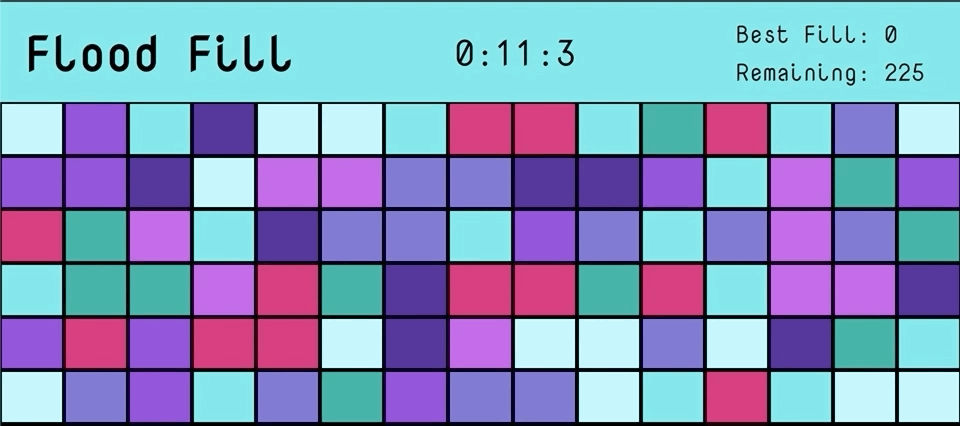Upon running the project, you will see a colorful grid of rectangles.
Currently, nothing happens when you click on a rectangle, but we would like to include interactivity.
When you click on a rectangle, we want it and any adjacent rectangles of the same color to turn black, as shown below:
- nodeJS
- If you do not have node installed, you will need to install it.
-
python3
- If you want to write your solution in python, you may need to install it.
-
python virtual environment
- If you're developing in python with external libraries, you should be using a virtual environment.
Ensure your computer meets the technical requirements above, then clone this repository.
After cloning the repository, change into the directory and install the dependencies with npm install.
Once the dependencies have been installed, you can start the project.
-
If you will be providing your algorithm solution in JavaScript, run
npm start. -
If you will be providing your algorithm solution in python, run
npm run start-py. -
If you will be solving the react portion only, run
npm run start-alg. This will start the project with the algorithm already implemented.
Open http://localhost:3000 to view the page in the browser.
The page will reload as you make edits to the JavaScript files.
You will see any linting errors in the browser console.
If you will be providing your solution in python, you will also need to install the python dependencies.
From a new terminal tab, ensure you have activated your virtual environment, then run npm run setup-py.
Once the dependencies have been installed, run npm run start-api.
To complete this task, implement the Flood Fill algorithm that will color the rectangles.
If your solution will be written in JavaScript, open up src/lib/solution.js and implement your solution inside the default export.
If your solution will be written in python, open up python/solution.py and implement your solution inside the named function.
Your function should follow the signature provided, which is (board, clickedItem) => updatedBoard.
You can expect board to be a 2-D array of items.
Each item is an object with a color property, as well as x, and y properties denoting their position in the 2-D array.
For example, a 2x3 grid might look like this:
board = [
[ { 'color': '#baddad', 'x': 0, 'y': 0 }, { 'color': '#ff7721', 'x': 1, 'y': 0 }, { 'color': '#adaaaa', 'x': 2, 'y': 0 } ],
[ { 'color': '#adaaaa', 'x': 0, 'y': 1 }, { 'color': '#ff7721', 'x': 1, 'y': 1 }, { 'color': '#ff7721', 'x': 2, 'y': 1 } ],
]
The updatedBoard you return should be of the same dimensions as the board you receive, and each item should contain the same properties as the original item, with an updated color property.
If an item is part of the flood fill, you should return null/None for its color to indicate that it has been filled.
The clickedItem that is passed to the function will be of the same shape as the other items on the board, but will include the color and coordinates of the clicked item.
You may use any resources at your disposal, and should feel free to ask questions.
You are encouraged to explain your thinking as you work through a solution.
Your task is to implement a custom header as follows:
Head to the folder src/components/solution, where you will find a few files.
You will have two main components to implement: Score.js and Timer.js, and one optional component, Header.js.
You should feel free to architect and style your components however you see fit, and may use any resources at your disposal.
Open up src/components/solution/Score.js and implement a Scorecard component.
The scorecard should keep track of the highest number of rectangles filled with a single click.
When a rectangle is clicked, the number of rectangles filled will be automatically calculated.
Its value can be consumed from the BoardContext which is a named export from src/context/BoardContext.js.
The context provides an object with key lastFill which will be the number filled on the previous click.
The provided object will also contain the key numLeft indicating the number of rectangles remaining. This should also be displayed.
Open up src/components/solution/Timer.js and implement a Timer component.
Your component should start timing when the page loads, and continue timing until the board has been completely filled.
It should display the elapsed time in minutes:seconds:milliseconds.
By default, your components will be rendered to the header automatically.
If you would like more control over the rendering, you can implement your own custom header by importing your components into src/components/solution/Header.js.

